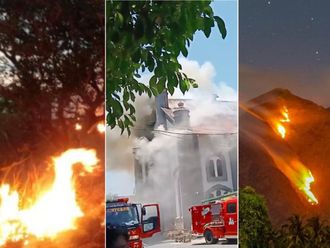Manila: More than one million people have been affected by Typhoon Hagupit, a grade four storm that has killed at least 27 people in central Philippines, with aid agencies warning that hundreds of thousands were left without food or homes.
The storm made landfall in the country on Saturday.
It destroyed bunkhouses, other structures and tents that were built by the government, and where thousands of residents stayed after Typhoon Haiyan, a strong grade five storm, ravaged the same area in November last year.
“We need rice, noodles, and basic food supplies,” said an official with a non-governmental agency that has been collecting money, food, and relief goods to distribute to more than people affected by the typhoon, which is also known as Ruby.
Images on TV showed typhoon victims walking aimlessly on the roads, some with placards written: “We need food. We are hungry.”
The Department of Social Welfare and Development did not say there was a shortage of food and other relief goods when it announced that 358,360 food packs were available at several field offices in affected areas in central Philippines and southern Luzon’s Bicol.
Evacuation centres
However, at the same time, the National Disaster Risk Reduction and Management Council said 1,074,080 people were already affected by Typhoon Hagupit, adding that some 1,062,237 people were brought to evacuation centres, while 230,569 people outside of evacuation centres were identified for food relief assistance.
“There is a clear shortage of 715,728 food packs for more than one million affected residents,” said observer Alfred Crespo of Changing Lives, Strengthening Families and Transforming Communities, a non-governmental organisation.
At the time, the department of social welfare and development had 44.66 million Philippine pesos (Dh3.72 million) and the local government units, P2.578 million (Dh214,833) for initial relief assistance.
“This means both agencies would need additional P94.356 million (Dh7.863 million to respond to the food and relief assistance needed by more than one million affected residents,” Crespo said, adding that natural disasters also spell economic loss.
The more than one million affected residents belong to the first wave of Typhoon Hagupit-affected residents based in seven regions, 25 provinces, 188 municipalities, and 1,547 villages, the NDRRMC said, adding its list did not yet include residents in southern Luzon, Metro Manila, and central Luzon who were affected by Typhoon Hagupit when it weakened and began a northwest course starting on Monday.
“In other parts of southern Luzon, Metro Manila and central Luzon, several local government leaders undertook enforced evacuations ahead of the arrival of Typhoon Hagupit on Monday. That means more funds for relief assistance,” Crespo said.
He did not give an estimate of what amount would be needed to respond to the relief assistance for the second wave of residents affected by Typhoon Hagupit.
Typhoon Hagupit has tested the government’s response to millions of people who were displaced by Typhoon Haiyan in November 2013.
On Tuesday, the local government of Tacloban announced new “transitional homes” for some 17,200 families of evacuees and survivors of Typhoon Haiyan, whose bunkhouses and tents were damaged by Typhoon Hagupit over the weekend.
“It means the bunkhouses and tents where the displaced residents had stayed for a year after Typhoon Haiyan were not resilient to typhoons. The government should erect more durable and permanent shelters,” Thaddeus Hinunangan, a medical student in Tacloban, told Gulf News in a phone interview.
The posts and walls of the proposed “transitional homes,” which measure 40 square metre per unit, are made of coconut lumber and leaf thatch (nipa).
The International Organisation of Migration (IOM) had also been funding the repair of damaged bunkhouses — a process that might prove challenging with the arrival of 21 typhoons that hit the Philippines annually.
Because of Typhoon Hagupit, classes were suspended in vast areas in eight regions and offices were suspended in three regions.
Some 2,663 passengers were stranded in seaports after 84 vessels, 644 rolling cargoes, and three small boats were not allowed to sail.
Meanwhile, 183 domestic flights were cancelled and five airports were closed — two in Bicol region, southern Luzon, three in central Philippines and one each in Masbate, Leyte, and Samar.
Power outages were experienced in 16 provinces in five regions. Two major telecommunication providers had no services in the typhoon-affected areas.
Ten national roads were closed due to floods, landslides, and fallen trees in two regions.
Elsewhere, 11 national roads were partly impassable due to floods, uprooted trees and toppled electric posts in three regions.
Seven local roads were not passable in southern Luzon and central Philippines.












